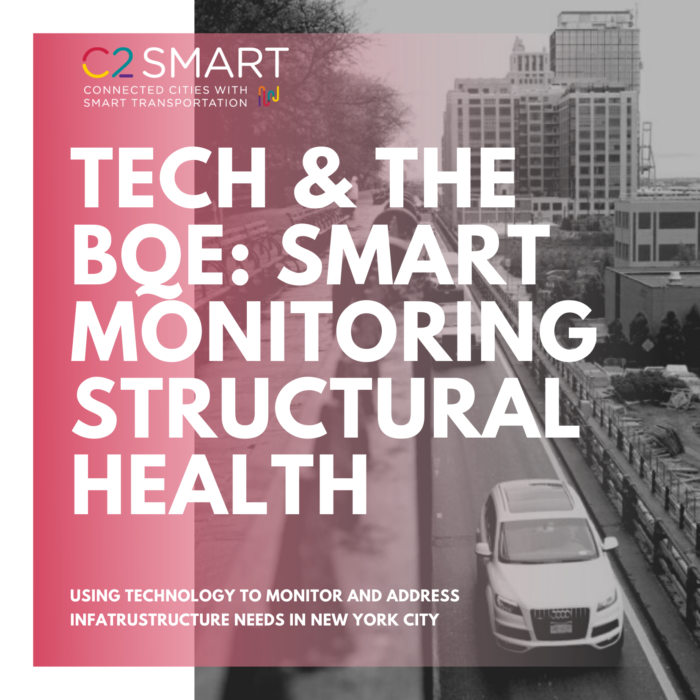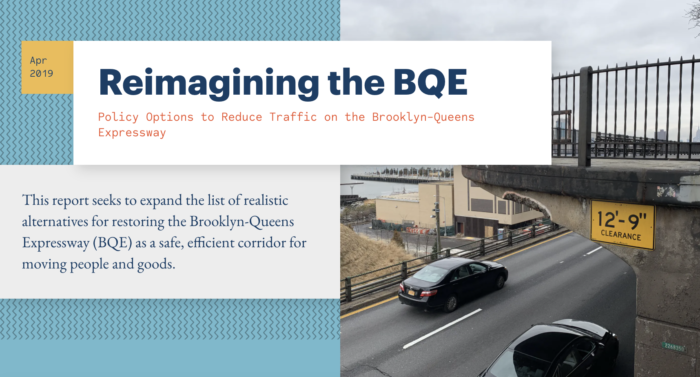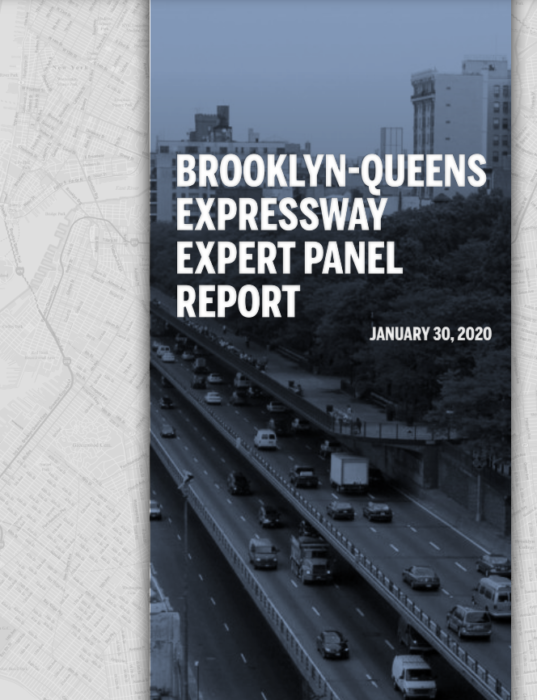C2SMART's NYC Urban Roadway Testbed
Structural Health Monitoring on the Brooklyn-Queens Expressway
The Brooklyn-Queens Expressway (BQE) handles substantial daily traffic, with an annual average daily traffic of more than 153,000 vehicles. The triple cantilever section, which splits the BQE on two cantilevers carrying three levels, has been disproportionately impacted by overweight trucks and environmental conditions. Less than half a mile long, the section became operational in 1948 and contains three eastbound lanes above three westbound lanes, topped by the Brooklyn Promenade. New data on the current traffic loads and state of the cantilever’s deterioration suggests that the presence of many overweight trucks – a function of limited monitoring and enforcement – coupled with deterioration of the cantilever could cause sections of the road to become unsafe and unable to carry existing levels of traffic within five years. The New York City Department of Transportation (NYCDOT) has long been planning to rehabilitate the deteriorated reinforced concrete sections of the bridge to accommodate the future traffic volume and weight demands.
C2SMART researchers from Rutgers University and NYU have been working with NYCDOT to plan, install, collect, and interpret from various types of sensors to effectively analyze behaviors of BQE’s concrete cantilever structures. The sensors will help to inform existing conditions of the cantilever sections and to warn of any abnormal behavior due to severe structural damages.
C2SMART on Mayor de Blasio's Expert Panel
NYC Mayor Bill de Blasio nominated an expert panel composed of leaders in the field, including C2SMART Director Kaan Ozbay, Associate Director Hani Nassif, and affiliate faculty member Mitchell Moss. This panel was tasked with crafting a comprehensive plan for a redesign of the highway. To do this, C2SMART researchers installed Weigh-in-Motion sensors to collect and analyze data regarding daily use of the BQE. Following this installation, the panel made several proposals for the longterm longevity and decongestion of the expressway.
These recommendations were informed in part by data from the C2SMART Weigh-in-Motion sensors and by USDOT- and other federally-funded research from C2SMART’s portfolio, including work on traffic management, bridge deterioration monitoring, highway capacity control, and collaborative, multi-agency highway construction. Ultimately, the panel called for permanent lane reductions, designated and wide shoulders, and the development of a demand management plan to reduce BQE volumes by 15% or more.
Installation of C2SMART Weigh-in-Motion (WIM) Sensors and Monitoring
In order to help the mayor’s expert panel to make recommendations for long-term rehabilitation of the BQE, C2SMART researchers designed and constructed a new “smart roadway testbed” along the cantilevered section of the BQE. This testbed collects real-time data on truck loads using weigh-in-motion (WIM) sensors to measure their impact on the roadway. These sensors and data are part of the first phase of C2SMART’s planned urban testbed to cover the full stretch of roadway, and others in New York City, while collecting data on the resiliency of structures as well as other valuable data on the critical transportation link and its effects.
The first batch of data collected from the WIM sensors showed that on the Queens-bound cantilevered section of the BQE 11.1% of trucks exceeded 80 kips. Higher live loads cause greater stress on the structure, shorten its lifespan, and jeopardize motorist safety. Continuing data collection from the sensors provides insights about the real-time condition of the roadway.
These data informed the final recommendations of the expert panel, and ultimately were used by Mayor Bill De Blasio in his executive order to limiting truck usage of the roadway and increasing enforcement. They have been a critical part of C2SMART’s planning for phase two of the testbed: designing and implementing a structural health monitoring plan.
Sensor Design and Installation
Long-term Structural Health Monitoring

Mayor Bill de Blasio and the NYCDOT released a comprehensive plan to extend the life of the Brooklyn-Queens Expressway (BQE) cantilever for at least another 20 years, while reimagining the corridor for a long-term future with less reliance on large, diesel trucks. The four-part plan focuses on preserving the structure; executing immediate and ongoing maintenance; expanding monitoring and enforcement; and developing a long-term, community-based vision for the entire corridor.
“To drive economic development, we must invest in sustainable roadways, and decrease our reliance on diesel trucks to transport goods,” said New York City Economic Development Corporation President and CEO Rachel Loeb. “Tens of thousands of New Yorkers depend on the BQE, and aging infrastructure and truck congestion have been long-standing problems. NYCDOT’s plan will work to address needed maintenance and repairs to make the expressway safer and will allow for commerce to move more efficiently, helping our city’s businesses and residents. NYCEDC will continue to support the city in its long-term vision to also ease truck congestion with water and rail solutions, which will reduce traffic and harmful emissions.”
The plan includes four key pillars of work: preserving the structure, immediate and ongoing maintenance, expanded monitoring, and developing a long-term vision for the future of the expressway.
The third element of the plan, expanded monitoring, is intended to mitigate short-term problems while long-term change takes place using smart sensors to monitor the structural health and overall performance of the most critical sections. Drawing on its unmatched expertise in urban informatics, connected technologies, behavioral informatics, and city partnerships, C2SMART will conduct comprehensive structural health monitoring and allow for data-driven decisions with analytical tools that will improve future assessments, predictions, and long-term monitoring of the BQE. As Congresswoman Nydia Velázquez explained, “Buying time now — by making needed repairs, lessening the heavy loads and putting in place ongoing monitoring to ensure it remains safe — is crucial as we engage communities along the corridor to find the best answers for a 21st Century solution.”
 In partnership with ThermalStare, Inc. and Structural Monitoring Solutions, C2SMART researchers have installed various types of sensors to effectively analyze behaviors of BQE’s concrete cantilever structures as part of a structural health monitoring plan to address immediate infrastructure needs while longer-term rehabilitation plans take shape. The sensors provide information on load effects such as deflection, strain, vibration, inclination/rotations, and temperature, as well as the resistance and condition of the concrete sections. This data will in turn improve future assessments, predictions, and long-term monitoring of the BQE, and provide information for data-driven decisions to ensure timely and cost-effective management of issues as they arise.
In partnership with ThermalStare, Inc. and Structural Monitoring Solutions, C2SMART researchers have installed various types of sensors to effectively analyze behaviors of BQE’s concrete cantilever structures as part of a structural health monitoring plan to address immediate infrastructure needs while longer-term rehabilitation plans take shape. The sensors provide information on load effects such as deflection, strain, vibration, inclination/rotations, and temperature, as well as the resistance and condition of the concrete sections. This data will in turn improve future assessments, predictions, and long-term monitoring of the BQE, and provide information for data-driven decisions to ensure timely and cost-effective management of issues as they arise.
“Every day, the safety of Brooklyn Heights residents and commuters hangs in the balance of a mere 1.5-mile stretch of the BQE,” said Carlo A. Scissura, President and CEO of the New York Building Congress and Chair of the BQE Expert Panel. “We recognized the risks the triple cantilever posed — and the greater needs to reimagine the entire BQE — when the Expert Panel gave its recommendations. Today’s measures, based in part on those findings, is a major step in the long road to ending our dependence on yesterday’s highways, reducing traffic-related emissions and returning open space to communities.”
C2SMART Project Group
New York University
 New York University (NYU) was founded more than 185 years ago with the goal of providing New York City (NYC) residents with an education as bold as the aspirations that drew their families to our shores. While remaining a gateway for regional students, NYU has received national and global recognition and today is the largest private research university in the U.S., enrolling approximately 50,000 undergraduate and graduate students each year. The NYU Tandon School of Engineering has a more than 160-year legacy rooted in the history of two great engineering schools: Polytechnic Institute of Brooklyn (Poly) and NYU Heights. In the fall of 2015, the Tandon family made a $100M gift to strengthen the importance and centrality of engineering to the growth of the university, and today NYU Tandon has nearly 5,500 undergraduate, graduate, and doctoral students.
New York University (NYU) was founded more than 185 years ago with the goal of providing New York City (NYC) residents with an education as bold as the aspirations that drew their families to our shores. While remaining a gateway for regional students, NYU has received national and global recognition and today is the largest private research university in the U.S., enrolling approximately 50,000 undergraduate and graduate students each year. The NYU Tandon School of Engineering has a more than 160-year legacy rooted in the history of two great engineering schools: Polytechnic Institute of Brooklyn (Poly) and NYU Heights. In the fall of 2015, the Tandon family made a $100M gift to strengthen the importance and centrality of engineering to the growth of the university, and today NYU Tandon has nearly 5,500 undergraduate, graduate, and doctoral students.
Rutgers University
 Rutgers, The State University of New Jersey, stands among America’s highest-ranked, most diverse public research universities. The oldest, largest, and top-ranked public university in the New York/New Jersey metropolitan area, Rutgers is an academic, health, and research powerhouse and a university of opportunity. Rutgers has the threefold mission of providing for the instructional needs of New Jersey’s residents through its undergraduate, graduate, and continuing education programs; conducting the innovative research that contributes to the medical, environmental, social, and cultural well-being of the state, as well as aiding the economy and the state’s businesses and industries; and performing public service in support of the needs of the residents of the state and its local, county, and state governments.
Rutgers, The State University of New Jersey, stands among America’s highest-ranked, most diverse public research universities. The oldest, largest, and top-ranked public university in the New York/New Jersey metropolitan area, Rutgers is an academic, health, and research powerhouse and a university of opportunity. Rutgers has the threefold mission of providing for the instructional needs of New Jersey’s residents through its undergraduate, graduate, and continuing education programs; conducting the innovative research that contributes to the medical, environmental, social, and cultural well-being of the state, as well as aiding the economy and the state’s businesses and industries; and performing public service in support of the needs of the residents of the state and its local, county, and state governments.
ThermalStare, Inc.
 ThermalStare develops and applies innovative infrared-based nondestructive evaluation technologies. Developed originally for civil infrastructure, ThermalStare technology is used for military, petrochemical, aerospace, automotive, and other applications. ThermalStare instruments measure defects in concrete, coatings, and other materials and measure properties of steel. For highway bridges and structures, measurements include bridge deck and soffit inspection, thermal stress measurement, coating assessment, and long-term monitoring systems. Services related to infrared assessment include inspection of bridge decks, tunnels, or other assets; inspection planning; and web-based inspection planning tools.
ThermalStare develops and applies innovative infrared-based nondestructive evaluation technologies. Developed originally for civil infrastructure, ThermalStare technology is used for military, petrochemical, aerospace, automotive, and other applications. ThermalStare instruments measure defects in concrete, coatings, and other materials and measure properties of steel. For highway bridges and structures, measurements include bridge deck and soffit inspection, thermal stress measurement, coating assessment, and long-term monitoring systems. Services related to infrared assessment include inspection of bridge decks, tunnels, or other assets; inspection planning; and web-based inspection planning tools.
Structural Monitoring Solutions

With 30 years of equipment manufacturing, SHM project management, data analysis, and expertise, Structural Monitoring Solutions seeks to provide bridge owners with straightforward solutions to complex problems through partnerships with the best universities, engineering firms, departments of transportation, and other proven manufacturing leaders in the field of asset management. SMS uses ruggedized fiber optics technology to minimize replacement cycles and lower incidences of power drops, installation labor, and maintenance, and have experience in remote monitoring, turnkey Installation, project management, instrumentation design, software data automation, long-term maintenance, and monitoring.













